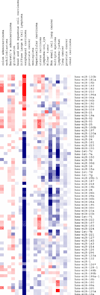dbDEMC: a database of differentially expressed miRNAs in human cancers
- PMID: 21143814
- PMCID: PMC3005935
- DOI: 10.1186/1471-2164-11-S4-S5
dbDEMC: a database of differentially expressed miRNAs in human cancers
Abstract
Background: MicroRNAs (miRNAs) are small noncoding RNAs about 22 nt long that negatively regulate gene expression at the post-transcriptional level. Their key effects on various biological processes, e.g., embryonic development, cell division, differentiation and apoptosis, are widely recognized. Evidence suggests that aberrant expression of miRNAs may contribute to many types of human diseases, including cancer. Here we present a database of differentially expressed miRNAs in human cancers (dbDEMC), to explore aberrantly expressed miRNAs among different cancers.
Results: We collected the miRNA expression profiles of 14 cancer types, curated from 48 microarray data sets in peer-reviewed publications. The Significance Analysis of Microarrays method was used to retrieve the miRNAs that have dramatically different expression levels in cancers when compared to normal tissues. This database provides statistical results for differentially expressed miRNAs in each data set. A total of 607 differentially expressed miRNAs (590 mature miRNAs and 17 precursor miRNAs) were obtained in the current version of dbDEMC. Furthermore, low-throughput data from the same literature were also included in the database for validation. An easy-to-use web interface was designed for users. Annotations about each miRNA can be queried through miRNA ID or miRBase accession numbers, or can be browsed by different cancer types.
Conclusions: This database is expected to be a valuable source for identification of cancer-related miRNAs, thereby helping with the improvement of classification, diagnosis and treatment of human cancers. All the information is freely available through http://159.226.118.44/dbDEMC/index.html.
Figures




References
-
- Forbes SA, Tang G, Bindal N, Bamford S, Dawson E, Cole C, Kok CY, Jia M, Ewing R, Menzies A. et al.COSMIC (the Catalogue of Somatic Mutations in Cancer): a resource to investigate acquired mutations in human cancer. Nucleic Acids Res. 2010;38(Database issue):D652–657. doi: 10.1093/nar/gkp995. - DOI - PMC - PubMed
Publication types
MeSH terms
Substances
LinkOut - more resources
Full Text Sources
Research Materials

